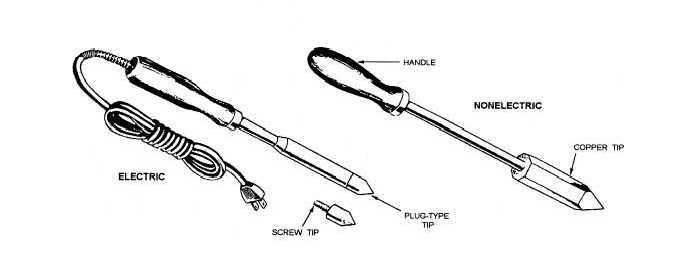CHAPTER 6 SOLDERING, BRAZING, BRAZE WELDING, AND WEARFACING
The information presented in chapter 5 covered the joining of metal parts by the process of fusion welding. In this chapter, procedures that do not require fusion are addressed. These procedures are as follows: soldering, brazing, braze welding, and wearfacing. These procedures allow the joining of dissimilar metals and produce high-strength joints. Additionally, they have the important advantages of not affecting the heat treatment or warping the original metal as much as conventional welding.
SOLDERING
Soldering is a method of using a filler metal (commonly known as solder) for joining two metals without heating them to their melting points. Soldering is valuable to the Steelworker because it is a simple and fast means for joining sheet metal, making electrical connections, and sealing seams against leakage. Additionally, it is used to join iron, nickel, lead, tin, copper, zinc, aluminum, and many other alloys.
Soldering is not classified as a welding or brazing process, because the melting temperature of solder is below 800°F. Welding and brazing usually take place above 800°F. The one exception is lead welding that occurs at 621°F. Do not confuse the process of SILVER SOLDERING with soldering, for this process is actually a form of brazing, because the temperature used is above 800°F.
This chapter describes the following: equipment and materials required for soldering, the basic methods used to make soldered joints, and the special techniques required to solder aluminum alloys.
EQUIPMENT
Soldering requires very little equipment. For most soldering jobs, you only need a heat source, a soldering copper or iron, solder, and flux.
Sources of Heat
The sources of heat used for soldering vary according to the method used and the equipment available. Welding torches, blow-torches, forges, and furnaces are some of the sources of heat used. Normally, these heating devices are used to heat the soldering coppers that supply the heat to the metal surfaces and thus melt the solder. Sometimes, the heating devices are used to heat the metal directly. When this is done, you must be careful to prevent heat damage to the metal and the surrounding material.
SOLDERING COPPERS. - A soldering copper (usually called a soldering iron) consists of a forged copper head and an iron rod with a handle. (See fig. 6-1.)

Figure 6-1. - Soldering irons.
Continue Reading